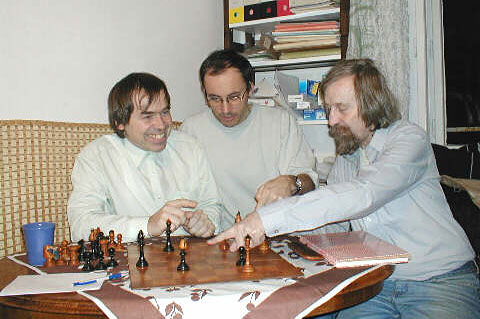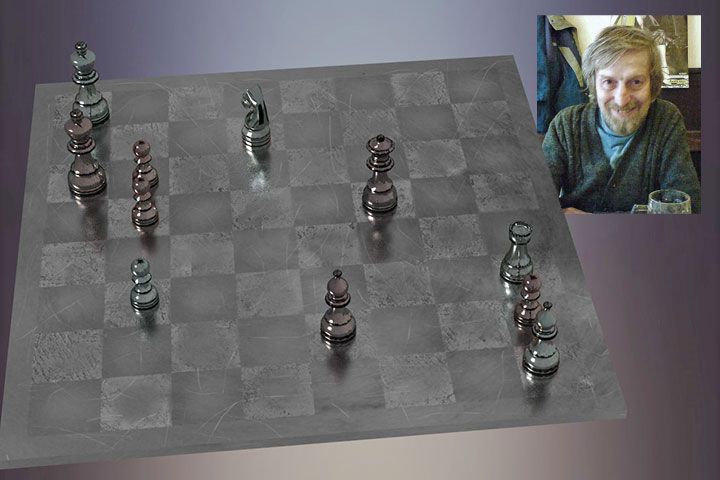Study of the Month: November 2019
As always, feel free to skip to the end and enjoy replaying the studies, if that's your preference.
While some chess players, notably Diemer, delved into the arcane arts, the pantheistic belief is that the spirit of God is in everything, and most religions agree that at least living beings are made from the divine breath. In that sense the artistic endgame studies of a chess composer, but also the fierce battles between two players, can be described as manifestations of spirit.
In the broadest sense the definition of magic is the change of the world by means of the spirit, “the Science and Art to cause change in conformity with will” (Aleister Crowley; although Donald Michael Kraig refused the definition as too broad), so the beautiful endgame studies of our protagonist today can be described as modern magic.
Matouš, who has created nearly 300 endgame studies (versions and corrections included), was born on June 16th, 1947, as son of two language teachers in a town 55km north-east of Prague. As intellectuals, the family suffered under the Communist regime, so very early in his life the mother was jailed for two years for purely political reasons, with the entire family persecuted. Father Matouš had to work for little money and Mario with his siblings went to nurseries for some time. Later on, Mario declined the “Pioneer” youth organizations to attend religious work instead. Due to the revenge of the regime in not allowing appropriate education, Mario had to find manual labour later, a struggle that accompanied him all his life as he wasn’t skilled there. Having learnt chess at the age of nine, one of his chess contacts got him an occupation after Mario had finished national service. In 1968, he became a master chess player and in 1971 won the Central Bohemian championship, qualifying for the semi-finals of Czechoslovakia. In the hardships, Mario developed a humour appreciated by his chess friends, which might also have influenced his composing.
Shortly thereafter, as IM Petr Špaček — who was friends with Matouš — recalled, according to Emil Vlasák, a chess tournament saw Matouš appearing in a suit after he had just attended a wedding. Of course, he was asked whose wedding: “My own.” The marriage fell apart quickly. In 1976, Matouš following an invitation by GM Eduard Meduna and Špaček started playing in the 1st Czechoslovak League for Tesla Karlin, named after a government-owned company that would employ Mario Matouš for many years.

Emil Vlasák, Jaroslav Polášek and Matouš at the EG study composers meeting in 2002
The company had no relation to Elon Musk’s American company of the similar name, despite both being named after Nikola Tesla and producing electronics. In fact, the Czechoslovak Tesla (Tesla a.s.), as we read in Wikipedia, produced nearly all electronics in the country until 1989 (including military), and in 2010 (now as Tesla Holding a.s.) after legal battles agreed to a peaceful coexistence with Musk’s Tesla Motors, Inc. (later Tesla, Inc.).
From 1980 to 1990 the TJ Spofa Prague became the club where Matouš played before turning mostly to chess composition, playing practical games only for fun. The foundations were laid with the publication of the first study in 1968 already, and around the same time he gained a commendation in the 1967 Rubinstein Memorial tourney for endgame studies, which however was published in April 1969. As a documentation of the already talented beginnings, his first published study is replayable in Vlasák’s article listed above (Kg5/Kg7) where you can also find another great success, the “Study of the Year 2007”, i.e. the study that was found to be the most suited for a general public.
Špaček and Matouš lived in an apartment together for a while, with Matouš proving his cooking skills but showing first signs of depression already. Once, he disappeared for days and then turned up with a young woman whom he took to his room — to play chess. This reminded of a song by Iván Mládek: “Vyklepnul jsem Denisu, 6:0, 6:0 v tenisu” (“I knocked out Denise, 6:0, 6:0 in tennis”). Of course, to someone who doesn’t understand Czech, the song, played by Mládek on a banjo-like instrument, sounds like a country song.
When he got composing, according to EG, days and nights without sleeping, drinking or eating could go by, but the Czeeh text reduces this to “next day” after writing the idea down (not telling how long he didn’t sleep, eat or drink), where Matouš just concentrated on his study, trying dozens of different settings, and eventually reaching a conclusion. Despite this, sometimes small mistakes slipped into the studies, as they do for every composer. The results were often “precise constructions in a classical and economical style” (Vlasák). The following ending of a study shows such an idea, but the prior introduction (not shown here) later had to be corrected by adding a black pawn on a2. We keep the original move count, starting at the fifth move.
After 5.♖de2+ ♚d1 6.♖a2! the checkmate threat leads to four different Nowotny interferences, i.e. a piece is sacrificed on a line (rank or file) and diagonal intersection so only one of the two threats can be defended against if capturing:
6...♚e1 7.♖g2 ♜f8 8.♗f6!, or 7...♜g8 8.♗g7!
6...♚c1 7.♗d4!
6...♜e8 7.♗e5!
6...♜f8 7.♗f6!
A great drawback of the works was that the knowledge of foreign compositions was limited, leading to sometimes less original settings. Within the energetic periods of composing, Matouš in such cases often created works that unknowingly improved his predecessors significantly. Ignoring the FIDE Albums (see my September column), the official titles of IM and GM for chess composition came not within his reach as they are tied to publications in the anthology. He was however multiple times Czechoslovakian or Czech master and obtained the FM title for chess composition.
Other interests included philosophy, in which he corresponded with his friendly composing rival Michal Hlinka. The German cultural critic Friedrich Nietzsche was a favorite of Matouš, and so he also asked about what beauty or art is, coming to the conclusion that it is “impossible to measure, weigh or prove the existence of Beauty. But I hope there is still a rich aesthetic feeling in ordinary man. Just in this I see a chance for a real artist to approach absolute Beauty.” (Letter from Matouš to Hlinka, as reproduced in EG 194.)
Having spent most of his life with his girlfriend in Prague, Matouš encountered issues in finding a job when the communist regime he hated fell. Eventually an occupation as night security guard turned up. Vlasák believes in his article that while Matouš remained at the highest compositional level, he became hackneyed and received more honourable mentions than prizes. In addition, our protagonist in 2009 fell ill with depression, and led an unhealthy lifestyle that shortly after his girlfriend’s death also culminated in the demise of Mario Matouš on July 4th 2013.
Let us close with the memory that (since 2017 GM for chess composition) Ladislav Salai jr. shared in the Czech article: After practical games, the team would sit down in a pub in Brno, and order two things: Something to eat from the pub and something to solve from Matouš.
Similarly, I hope the selection below will satisfy your hunger for beauty.
Thanks go to Emil Vlasák for providing photos. His articles are used as source: Zemřel Mario Matouš in Československý šach 7/2013 (with Ivan Hausner and Jaroslav Polášek) as well as the obituary in EG 194 which seems to be an abridged version of the Czech text, similarly his article on ChessBase.
Click or tap an entry in the list to switch positions
You probably know that you can move pieces on our replay boards to analyse and even start an engine to help you. You can maximize the replayer, auto-play, flip the board and even change the piece style in the bar below the board.
At the bottom of the notation window on the right there are buttons for editing (delete, promote, cut lines, unannotate, undo, redo) save, play out the position against Fritz and even embed the ChessBase game viewer on your website or blog. Hovering the mouse over any button will show you its function.
Perfect endgame analysis and a huge increase in engine performance: Get it with the new Endgame Turbo 5! This brings the full 6-piece Syzygy endgame tablebases on a pendrive. Just plug it in a USB socket and you are set!

World Federation for Chess Composition (www.wfcc.ch)
Links

























